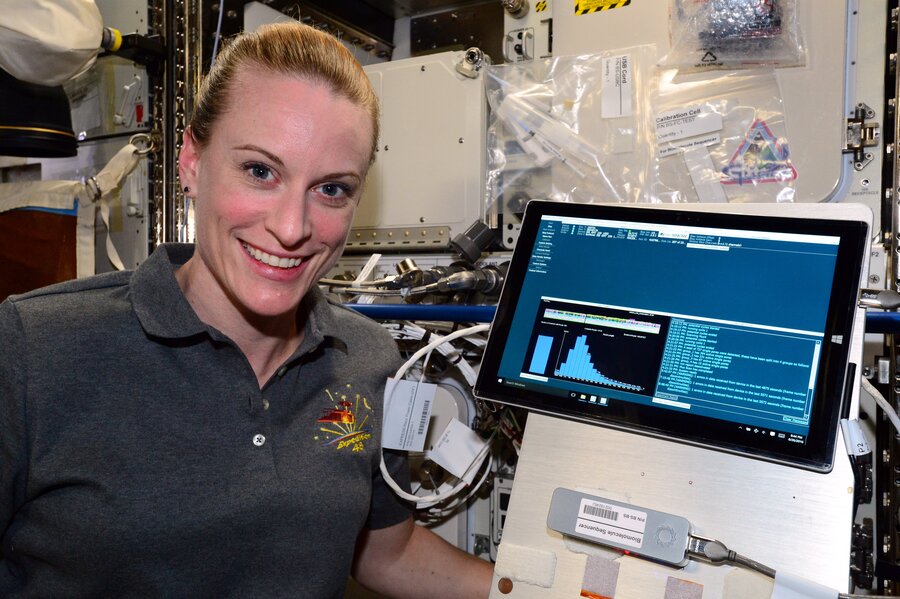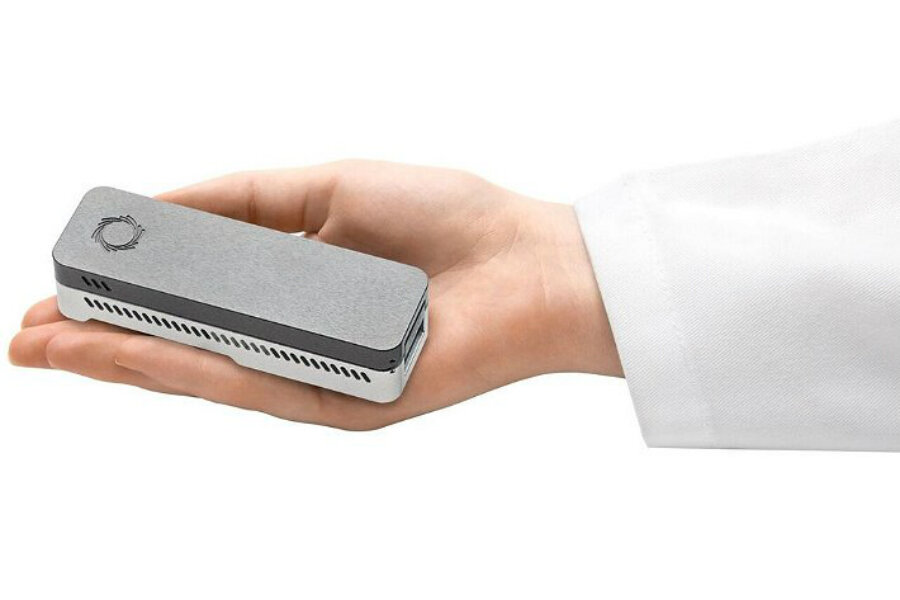Astronaut becomes first person to sequence DNA in space
Loading...
There are a lot of things astronauts can do in space. But until now, DNA sequencing was not one of them.
Last week, NASA astronaut Kate Rubins became the first person to sequence DNA in space. The experiment, conducted aboard the International Space Station (ISS), was made possible by a handheld sequencer called MinION. The new device could allow astronauts to identify molds or bacteria aboard spacecraft and perhaps even catalog life on other worlds.
“The test of the Biomolecule Sequencer on ISS is an important first step to learning how to sequence macromolecules like DNA in space,” Jason Dworkin, a biochemist at NASA’s Goddard Space Flight Center, says in an email to The Christian Science Monitor. “This is important to search for evidence of life elsewhere in the solar system – Mars, Europa, Enceladus – and be able to distinguish it from any biological contamination we brought with us from Earth.”
Spores, molds, and fungi are a part of life – even in space, they can latch onto surfaces or thrive in water reserves. With DNA sequencing, astronauts can identify these microbes and make informed in-flight decisions. But before NASA’s successful trial, there was no way to sequence DNA aboard the ISS or any other crewed spacecraft. All samples had to be sent back to Earth for testing.
In an effort to remedy this limitation, NASA launched its Biomolecule Sequencer investigation. The mission had just one objective: “to demonstrate, for the first time, that DNA sequencing is feasible in an orbiting spacecraft.” To achieve this goal, researchers needed compact sequencing technology – not the cumbersome machines commonly used back on Earth.
So the agency enlisted the aid of Oxford Nanopore Technologies. The UK-based tech company’s MinION sequencer, which is smaller than a smartphone, uses tiny holes called nanopores to analyze genomic data in real time. The device passes an ionic current through the nanopores, measuring changes in the current as organic molecules pass by. These changes can be used to identify each molecule.
Researchers on the NASA Extreme Environment Mission tested one MinION device underwater, and SpaceX’s Dragon spacecraft delivered another to ISS. Both trials were successful, but when testing new technologies in spaceflight environments, there are always unknowns.
“We developed protocols and included additional hardware to try to address any potential issues that may come up, but until you actually execute your process, it’s difficult to know what to fully expect,” Kristen John, an aerospace engineer at NASA’s Johnson Space Center, told the Monitor in an email. “For example, bubbles can have a negative impact on the nanopores on the ground, and we didn’t know what to expect in terms of bubble formation within the flow cells in microgravity.”
Ultimately, the bubbles proved a non-issue. The success of NASA’s preliminary experiment could have considerable scientific implications – both in space and back on Earth.
DNA sequencing is a costly and time-consuming process, but a relatively cheap miniature sequencer could benefit scientific endeavors in remote locations and developing countries. And portable, spaceflight-compatible sequencing technology could one day be integrated into the search for alien lifeforms.
“These early tests on ISS could eventually lead to novel approaches for finding life elsewhere, because the technology has the ability to detect many different kinds of biomolecules, not just DNA or RNA,” Mark Lupisella, a NASA systems engineer, tells the Monitor. “If extraterrestrial life has different chemistry from life on Earth, this kind of technology could be a way to not only detect it, but also to learn details of its molecular sequences – its blueprint – a holy grail for astrobiology.”









